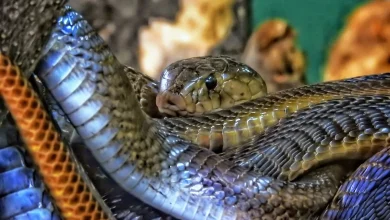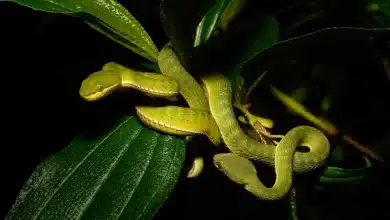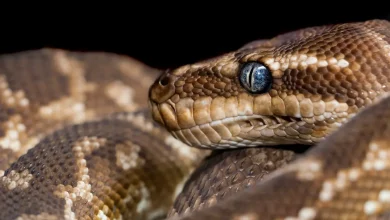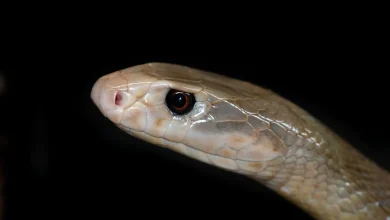Are White Snakes Rare? Where Can I Find One?
White snakes rarely occur in the wild and usually only as the result of albinism or leucism. White snakes are the result of a mutation in the genes during reproduction that prevents the production of melanin. Melanin is a pigment that gives animals (and us) color in the cells.
Many people see white ball pythons, sea snakes, and other naturally white-colored snakes and think that there must be a lot of white snakes naturally occurring in the wilderness. That really isn’t so, as white is not a very good color for camouflage in most instances.
There aren’t any snakes in Antarctica or Greenland, where the color might help them blend in. Do you know? Snakes naturally develop colors and patterns that help them fit in with the habitat they prefer to live in.
Snakes Having White Color
Where I live in Southeast Asia (SEA), we have a few snakes with solid areas of white on them but not really too many out of the 220+ snakes we have in the country (Thailand). In surrounding areas here in SEA they have very similar snakes to us so we rarely see any completely white snake.
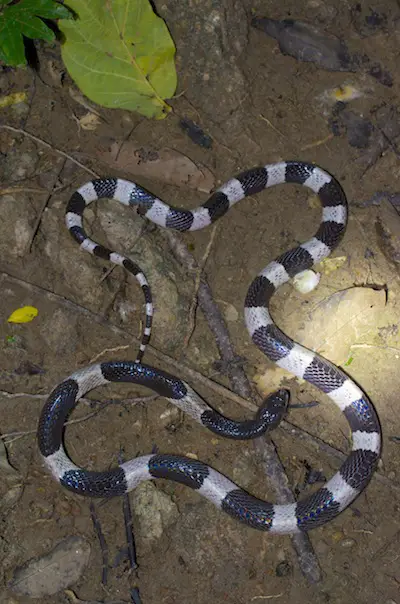
The Blue krait (B. candidus) is a snake that has black and white bands running down the length of the body from the neck to the tail. The white is very white, and occasionally pinkish in color. These pink-white kraits are rather common in this area.
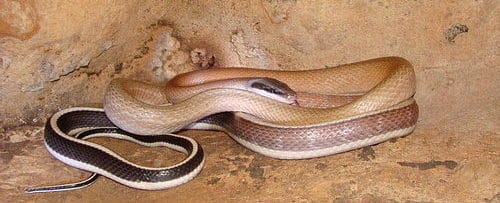
The Cave Racer (O.t. ridleyi) has white stripes on the tail that are brilliant white. Other than the krait above, this is probably the snake with most white on it in our area.
Snake Belly Is Often White
When you see a snake from underneath especially when it is up in a tree, you can see that the belly (ventral scales) are often white. This is true for many snakes around here including the Golden Tree Snake, Green Whip Snake, Speckle-headed Whip Snake, the Laotian Wolf Snake, some of the bronzeback snakes, and especially the White-bellied Rat Snake (P. fusca). In Africa, the black mamba has a white belly. In the United States, some of the rattlesnakes have white bellies too.
This white color on the ventral side of the snake makes it very easy to spot at night when they are in the trees. This is what some people call ‘herping.’ Herpers spot snakes during day or night and take photos or capture them for video or feeding and let them go later.
If you’re wondering if there’s an active group of herpers in your area of the world – whether USA, CA, Europe, Australia, or just about anywhere – you can be sure there is. If there are reptiles and amphibians, there are herpers around looking for white-bellied snakes!
Albino and Leucistic White Snakes
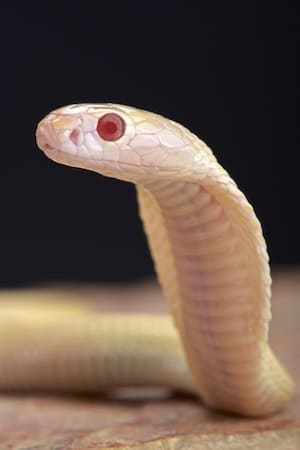
This white snake is a cobra, the Naja kaouthia. Usually dark brown or black with a pattern on the back of the neck like a monocle (eye-glass), this one is called a Monocled Cobra.
A true albino snake is white with pink eyes. There is no color to their interstitial skin or scales, so they appear white and without a pattern. These white snakes are very hard to identify if you’re not an expert in the snakes in that area of the world. There are no clues to help you identify a white snake except scale size, scale placement, and general body type.
It won’t be too hard to identify an albino or leucistic cobra. They have the same body as a regularly colored and patterned cobra, so it will flare its neck to form a hood when you are too close. Recently I saw photos of a white albino krait that was quite difficult to figure out at first.
Here is a photo of a very rare leucistic cobra. They can have black or blue eyes.
Problems of White Snakes
White snakes have 2 primary problems.
- They are white and they are in contrast with dirt, sand, dead leaves, tree bark, leaves on trees, rocks, sidewalks, literally everything. What’s white in nature? Very little! That means survival to adulthood is not likely because predators can very easily see a pure white snake anywhere it tries to hide except underground.
- Because they are so rare, mankind takes them from the wilderness and puts them in cages so they can sell to others and make a lot of money. Here in Thailand white snakes, especially cobras, can fetch a huge price.
- In addition to white snakes being super rare and valuable because of their color, they are also thought of as VERY LUCKY to have. People pay crazy amounts of money to own one of these snakes. The more venomous, the better!
Where Can You Find a White Snake?
Good question. I’ve never found one in fifteen years of looking for snakes in very snake-rich habitat. I’ve found over a thousand snakes. None of them were white. Now, I do have to mention that one time at night I was herping and I saw a white tail disappear into some rocks. It drove me crazy because I think I missed seeing an albino white snake. I can’t figure out what kind of animal it was except a snake.
Have YOU ever found one?
If you have a photo, send it in and I’ll put it here.
If you’re looking for Black and White Snakes – GO HERE >
If you want to know how to identify snakes by looking at the variables that define them and differentiate them, see our “How To Identify a Snake?” post.

